
The Resistance Medal was a decoration bestowed by the French Committee of National Liberation, based in the United Kingdom, during World War II. It was established by a decree of General Charles de Gaulle on 9 February 1943 "to recognize the remarkable acts of faith and of courage that, in France, in the empire and abroad, have contributed to the resistance of the French people against the enemy and against its accomplices since 18 June 1940".

The Distinguished Service Medal (DSM) was a military decoration awarded until 1993 to personnel of the Royal Navy and members of the other services, and formerly to personnel of other Commonwealth countries, up to and including the rank of Chief Petty Officer, for bravery and resourcefulness on active service at sea.
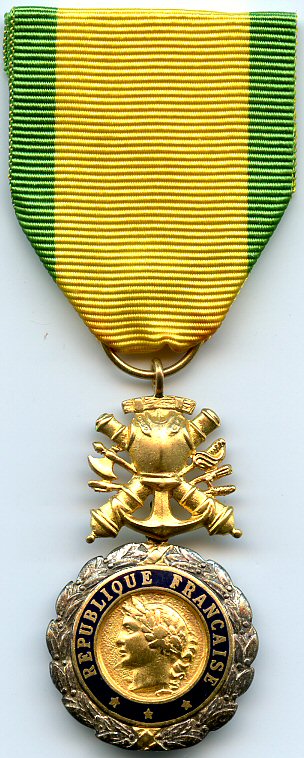
The Médaille militaire is a military decoration of the French Republic for other ranks for meritorious service and acts of bravery in action against an enemy force. It is the third highest award of the French Republic, after the Legion of Honour, a civil and military order, and the Order of Liberation, a Second World War-only order. The Médaille militaire is therefore the most senior entirely military active French decoration.

The Military Medal (MM) was a military decoration awarded to personnel of the British Army and other arms of the armed forces, and to personnel of other Commonwealth countries, below commissioned rank, for bravery in battle on land. The award was established in 1916, with retrospective application to 1914, and was awarded to other ranks for "acts of gallantry and devotion to duty under fire". The award was discontinued in 1993, when it was replaced by the Military Cross, which was extended to all ranks, while other Commonwealth nations instituted their own award systems in the post war period.

The Air Force Medal (AFM) was a military decoration, awarded to personnel of the Royal Air Force and other British Armed Forces, and formerly to personnel of other Commonwealth countries, below commissioned rank, for "an act or acts of valour, courage or devotion to duty whilst flying, though not in active operations against the enemy". The award was discontinued in 1993 when all ranks became eligible for the Air Force Cross (AFC) as part of the reform of the British honours system.

The Distinguished Flying Medal (DFM) was a military decoration awarded to personnel of the Royal Air Force and other British Armed Forces, and formerly to personnel of other Commonwealth countries, below commissioned rank, for "exceptional valour, courage or devotion to duty whilst flying in active operations against the enemy". The award was discontinued in 1993 when all ranks became eligible for the Distinguished Flying Cross (DFC) as part of the reform of the British honours system.
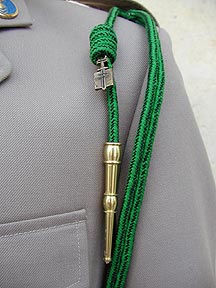
The Order of Liberation is a French Order which was awarded to heroes of the Liberation of France during World War II. It is a very high honour, second only after the Légion d’Honneur. Very few people, military units and communes were ever awarded it; and only for their deeds during World War II. A different order, the Médaille de la Résistance, was created and awarded for lesser but still distinguished deeds by members of the Resistance.
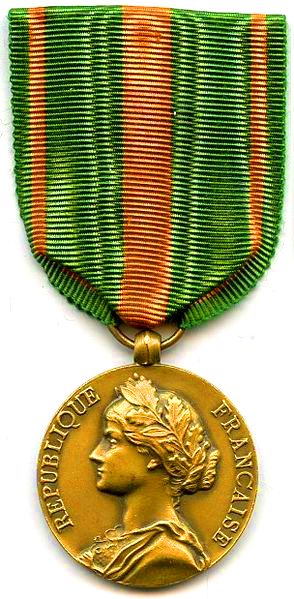
The Escapees' Medal is a military award bestowed by the government of France to individuals who were prisoners of war and who successfully escaped internment or died as a result of their escape attempt. The "Escapees' Medal" was established by a 1926 law, intended to honour combatants not only of the First World War, but also of the Franco-Prussian War of 1870. Its statute was later amended to include combatants of the Second World War and later conflicts.

The Indian General Service Medal was a campaign medal approved on 3 August 1938, for issue to officers and men of the British and Indian armies, and of the Royal Air Force.

Medal of Victory and Freedom 1945 was a Polish military decoration awarded to persons who fought during World War II against Nazi Germany.
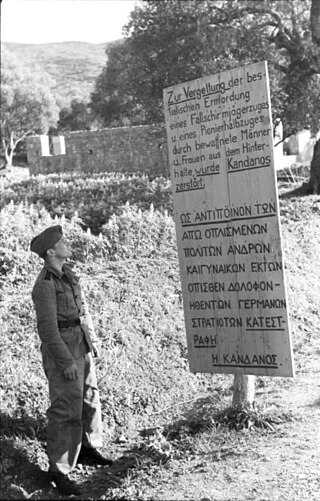
The Cretan resistance was a resistance movement against the occupying forces of Nazi Germany and Fascist Italy by the residents of the Greek island of Crete during World War II. Part of the larger Greek resistance, it lasted from 20 May 1941, when the German Wehrmacht invaded the island in the Battle of Crete, until the spring of 1945 when they surrendered to the British. For the first time during World War II, attacking German forces faced in Crete a substantial resistance from the local population. In the Battle of Crete, Cretan civilians picked off paratroopers or attacked them with knives, axes, scythes or even bare hands. As a result, many casualties were inflicted upon the invading German paratroopers during the battle.

The Australia Service Medal 1939–1945 recognises service in Australia's armed forces, Mercantile Marine and Volunteer Defence Corps during World War II.
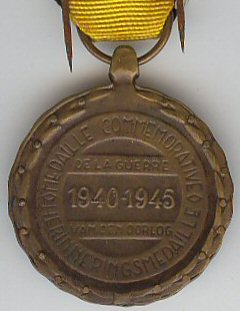
The Commemorative Medal of the 1940–45 War was a military decoration of Belgium. It was established by royal decree of the Prince Regent on 16 February 1945 to recognise Belgian servicemen and women who served during World War II. It was also awarded to members of the Belgian Resistance and members of Belgium's Merchant Navy on the side of the Allies. Later decrees allowed for its award to foreign recipients of the Belgian Croix de Guerre.

The Medal of French Gratitude was a French honour medal created on 13 July 1917 and solely awarded to civilians. The medal was created to express gratitude by the French government to all those who, without legal or military obligation, had come to the aid of the injured, disabled, refugees, or who had performed an act of exceptional dedication in the presence of the enemy during the First World War. The creation of this distinction was mainly the result of unsuccessful offensives of General Nivelle in 1917 and the serious crisis of confidence in France. The French government thus wanted to thank those who, despite the crisis, were always volunteering. It has three classes: bronze, silver, and gold. Nearly 15,000 people and communities were recipients of this award. The medal is no longer awarded, the last award was on 14 February 1959.

The Allied Subjects' Medal was a British decoration, distributed by the Foreign Office, to citizens of allied and neutral countries who gave assistance to British and Commonwealth soldiers, mainly escaped prisoners of war, behind enemy lines between 1914–1918. Originally instituted in 1920, delays caused by discussions within Government on the precise form and design of the award meant that it was only manufactured and distributed in 1922.

The King's Medal for Service in the Cause of Freedom is a British medal instituted by King George VI on 23 August 1945. It was awarded to civilian foreign nationals, mainly of allied countries, who had given meritorious service to further the interests of the British Commonwealth or the Allied cause during World War II. Activities recognised included fund raising for British war relief, scientific research that aided the war effort and organising ambulance services. The medal was awarded 2,539 times.
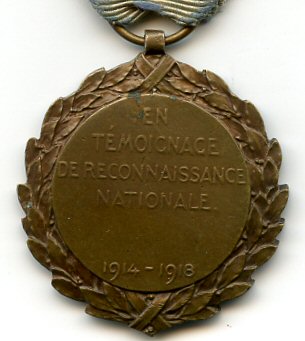
The Political Prisoner's Medal 1914–1918 was a Belgian medal established by royal decree on 26 December 1930 and awarded to Belgian civilians who were detained for a minimum of one month by the Germans during the First World War following an act of courage or devotion towards the Allies' cause.
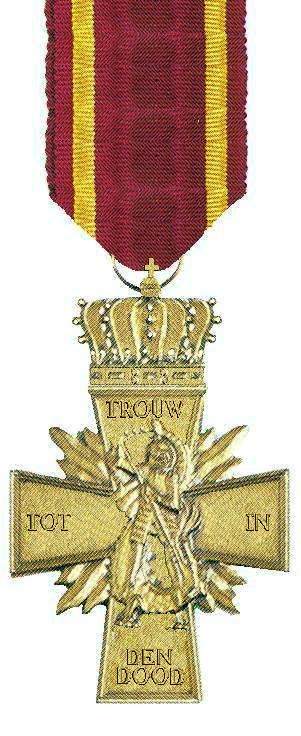
The Verzetskruis 1940–1945 is a decoration for valour in the Netherlands. Instituted on May 3, 1946, it was awarded in recognition of the individual courage shown in resistance against the enemies of the Netherlands and for the maintenance of liberties. It is one of the highest decorations in the Netherlands.
George James Doundoulakis was a Greek American physicist and soldier who worked under British Intelligence during World War II with SOE agent Patrick Leigh Fermor, and then served with the OSS in Thessaly, Greece.
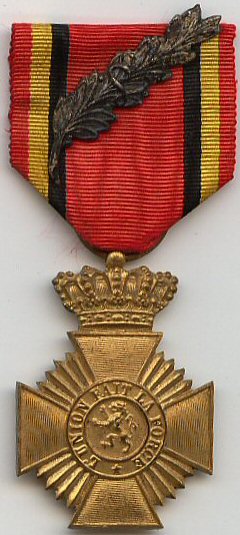
The Military Decoration for Exceptional Service or Acts of Courage or Devotion is awarded to personnel of the Belgian Armed Forces for either displayed herorism or for display of extraordinary devotion to duty. In history, sometimes it is referred to as an 'Article 4' award, as originally, the medal was created as a variation of the military decoration for long service. However, nowadays, both medals are distinct awards, albeit still having the same guilt cross.




















